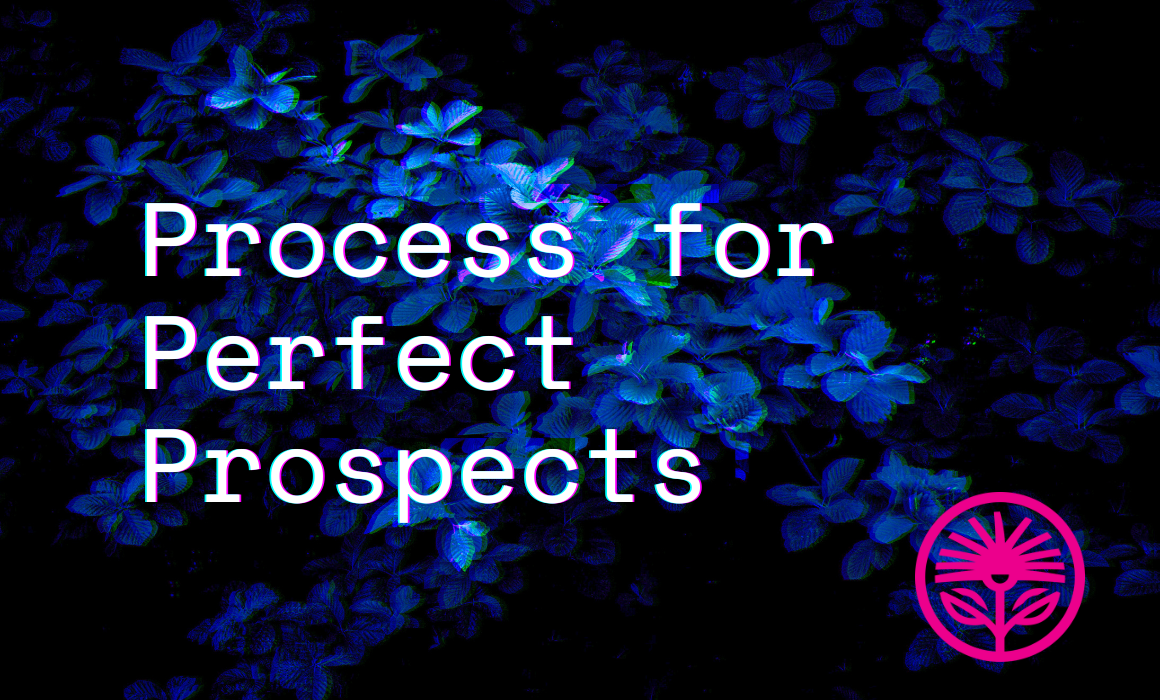A Process for Perfect Prospects — Kelford Labs Weekly
Follow this and grow.

“W. Edwards Deming, father of the quality movement, may have put it best: ‘If you can’t describe what you are doing as a process, then you don’t know what you are doing.’”
— Christensen, Hall, Dillon, and Duncan in Competing Against Luck
Identifying our ideal clients is a process.
It’s not something we do once a year, or once and then never again. It’s something we’re always doing, always working on and toward.
Which requires us to have a process to follow, a framework to ensure we’re making progress.
It’s easy to think that finding our ideal customers is about the market, the opportunity, or the future. When, in fact, it’s about us, our current clients, and our present prospects.
It’s not about a fictional, fantastical persona we hope to attract—it’s about the real clients we already have and the real prospects we’re already finding. And it’s about finding more of the best ones by focusing on the value they care about most.
This week’s newsletter is a ten-step process for identifying your ideal clients, by starting with your current clients:
Step 1: Defining Your Current Value
“Your point of view should answer your audience’s pivotal question: Why should I listen to you?”
— Rochelle Moulton in The Authority Code
First, we have to ask ourselves, “What is it that I really, truly, do?”
Imagine you had to explain your work—the thing you do for your clients—without using any industry jargon, and without assuming any knowledge on the part of the listener.
How would you describe what you do in simple, concrete terms?
So, instead of saying that I make marketing positions, value propositions, and marketing messages for hands-on entrepreneurs—which assumes a fair bit of knowledge—I might say something like, “I teach entrepreneurs the words they should use to attract more of their best customers.”
You’re not writing copy here, or anything for public consumption, so don’t worry about making it fancy. Just make it simple, accurate, and clear.
In step 4 you’re going to refine it based on additional evidence.
Okay, have you written it down? Let’s move on, then.
Step 2: Identifying Your Best Current Customers
“There is no greater source of distrust than advisors who appear to be more interested in themselves than in trying to be of service to the client.”
— Maister, Green, Galford in The Trusted Advisor
Now, it’s time to take a look at our current client roster and identify our most profitable clients, both financially and emotionally. That is, the clients that paid us fairly and who were enjoyable to work with.
Take special note of the clients who seemed to especially value the, well, value you identified in step one.
Identifying financially profitable clients is usually fairly easy, but figuring out which ones were emotionally profitable might be a bit tougher.
But just think back on the project, on the work, on the result.
Does it make you feel good to reminisce, or does it make you feel bad remembering how it went?
If you have many to choose from, narrow it down to a list of your five best.
Before we move on, make sure you’ve got a clear statement about what you do and a list of the five best clients you did it for.
Step 3: Finding Commonalities
“Your Probable Purchaser is the type of person who is perfectly suited to what you’re offering.”
— Josh Kaufman in The Personal MBA
Now, let’s take your list of your five best clients and find the overlaps.
What role in their organization do they have in common?
What values do they share?
What purchasing behaviors are similar across them all?
What problems do they all have in common?
Note what each client specifically got from you in terms of value, and identify the similarities all your best clients share.
Basically, you’re making a big Venn diagram that demonstrates the one or two traits, characteristics, or challenges that all of your best clients experienced.
Keep working on this, and keep thinking about it, until you find one or two clear areas of overlap.
When you’ve identified what they all share in common, it’s time to move on.
Step 4: Pinpointing Value
“Perhaps countless people can make similar products. But tell the pains you take to excel.”
— Claude C. Hopkins in My Life in Advertising
Now, you have a picture of what your ideal clients get from you, what they have in common, and an idea of why they found your services so appealing and valuable.
At this step, all we need to do is pinpoint that value, and turn it into a clear statement.
For instance, all of my best clients come to me because they don’t know what to say. They had an urgent need to know the right words, in the right place, at the right time, to attract more of their ideal clients.
Your clients might all share a similar type of challenge and a similar type of purchasing behavior. They might all share a role in their organization, and a similar way of assessing the value they received.
Combine those elements—who they are and what they value—into a single clear statement. Something like, “My best clients are mid-career professionals in large FinTech organizations who assess value based on its ability to grow their role/position in their organization.”
So, what is the one thing your best, current clients need from you?
Got it? Now let’s figure out when they need you.
Step 5: Identifying the Best Time
“Be careful about surprises. You don’t want to think of good leadership as looking at mountains of confusing data and pulling out that surprise insight that changes the world.”
— David C. Baker in The Business of Expertise
Finding our ideal clients is a process of layering and sorting information—information that might seem obvious—instead of creating something from scratch.
It’s not about fictional personas or fantasy prospects, it’s about identifying what’s really happening and who really cares about your value.
So, in this step, we ask ourselves: When did our five best clients reach out to us?
Or when did we first get the lead that led to us working together?
This should be simple and obvious—all we need to do is ask them, or ourselves, the question.
What time of day was it? Time of year? Season?
When did they need you, and when did you realize you could help?
You’ll probably have a list of a few different times, and that’s okay. This will become a list of opportunities at which you can approach more of your ideal prospects in the future. So more is okay, just make sure they’re real.
Have the beginnings of a list of times when your best clients needed you? Now let’s find the places.
Step 6: Identifying the Best Place
“We need to be able to put things into categories so we know where they fit. And you as the creator need to be clear and honest with yourself about where this work is going to fit for people.”
— Ryan Holiday in Perennial Seller
Now that we know when our best clients needed us, the next question is where were they or where did they go when they experienced that need?
Did they run to Google? Reddit? LinkedIn? A trade association? A trusted peer or colleague?
Your ideal clients probably share a pattern here, a way of looking for help that led them to you.
The idea is to be able to find more of your best clients by having more of a presence in the places they look.
Again, this might be a hefty list, and you’ll eventually narrow it down. But for now, focus on making the list and we’ll refine it later.
Ready? Let’s start focusing.
Step 7: Refining and Focusing
“The narrower our claim of expertise, the more integrity we earn.”
— Blair Enns in The Win Without Pitching Manifesto
Now here’s the most counterintuitive part:
Take your list of five best clients, and remove one.
Identify which of the five is least like the others and take it off your list.
Why? Because we humans like to be thorough, and we like to be fair. And so we often unconsciously unfocus when we make lists.
So, probably, without even realizing it, you added a client to your list who didn’t actually fit. Who you thought should be in your list even if the criteria didn’t place them there.
Maybe they don’t share a role or type of business with the others. Maybe you did something different for them than you did with the rest of your list.
Whatever it is, this is your opportunity to remove them before they unfocus your marketing efforts, too.
Down to a list of four? Great, let’s summarize what we discovered.
Step 8: Summarizing Your Findings
“The essence of marketing is narrowing the focus. You become stronger when you reduce the scope of your operations. You can't stand for something if you chase after everything.”
— Trout & Ries in The 22 Immutable Laws of Marketing
Now you want to articulate a clear statement about your value and how your best clients experienced it.
Take the information from Steps 2 and 3 and generalize a little bit until you have a description of your best clients. Write a brief blurb or bio about them, based on the real information you compiled.
Take the information from Steps 1 and 4 and summarize the value you provided to them. Make it clear, specific, and based on real client experiences.
From Step 5, summarize when they need you most. What time of day? When in the year? What particular part of the season?
From Step 6, summarize where they go to find someone like you.
That’s essentially, your new marketing position. It tells you the people you need to focus on, with what promise of value, at what particular time, and in what specific place.
The job now is to reinforce that position in all of your marketing so you get more of your ideal clients.
Ready?
Step 9: Reinforcing Your Position
“Competitive advantage comes from the way its activities fit and reinforce one another. Fit locks out imitators by creating a chain that is as strong as its strongest link.”
— Michael E. Porter in What is Strategy?
Now that you know who your best current clients are, the value they receive, when they need it, and where they go, you have a complete picture of what to do more of to find more of them.
Speak to prospects like them, about that value, in those places, at those times.
Do you have content, for instance, that specifically addresses these clients? Does it focus on the value they appreciate most? Are you publishing it at the right times, and in the right places?
When you do that, you’ll gradually increase the proportion of ideal clients in your roster by finding more clients like your best.
Just make sure you use clear language, that you’re direct, and that you’re specific.
From here, it’s all about measuring and making it even better based on evidence.
Step 10: Measuring and Adjusting
“The best marketing tool is a satisfied client.”
— Gerald M. Weinberg in The Secrets of Consulting
As you work to find more ideal clients, you’ll need to measure and adjust your actions.
So track the results of your work by noticing how your prospects respond to the words you’re using and the messages you’re sending.
Notice whether you’re attracting more leads that look more like your best current clients.
And test out marketing language on existing ideal clients to see how they respond.
Because if they don’t get it, prospects probably won’t either. But if they respond positively, if they start using the same language when you speak with them or when they refer clients to you, you know you’re on the right track.
Now what?
The biggest mistake I see businesses make when identifying ideal clients is making them up.
Fantasizing about a fictional ideal and wondering how they can attract clients that don’t actually exist.
When, instead, it’s both so much easier and so much more effective to start with the clients you already have. Growing your proportion of best clients by focusing on what they care about most.
And then you never stop—you constantly refine and refocus on the new best clients.
Because marketing is never done, and focusing is never finished.
You don’t identify your ideal once and wash your hands of it and get to work.
Because the work is the focusing.
This framework will help you keep focusing, and keep finding more of your best clients.
By basing your efforts on what’s real—and not merely what feels ideal.
Kelford Inc. shows you the way to always knowing what to say. Marketing positions and messages for hands-on entrepreneurs.



